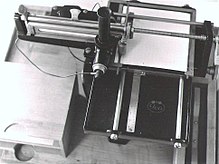Densograph
The comparative densograph according to Emanuel Goldberg enables the direct comparison of the brightness of one point of a gray wedge with that of a contact copy of the wedge on film .
In the instrument, the light of small incandescent lamps behind the gray wedge and its image on the film to be examined is placed next to one another using a Lummer-Brodhun cube . Connected to the film sample is a slidable punching device above a table that can be adjusted across it and on which a sheet of coordinate paper is stretched. The table travel corresponds to the length of the gray wedge located under the prisms and the eyepiece, the density of which goes from zero to log 4. The punch also makes the path of the wedge length.
At any distance, for example in steps of log 0.2, you adjust the table with an appraising eye until you get the impression of equal brightness in comparison, and then press the punch down. This creates a series of fine holes in the paper, which can then be interpreted as a characteristic curve of the film sample, possibly traced. The ideal film, ideally developed, would reproduce the wedge unadulterated, creating a straight line on the paper.
literature
- Hugo Lichte, Albert Narath: Physics and technology of the sound film . Hirzel, Leipzig 1941, pp. 232–233, (also: 3rd edition. Ibid. 1945).
